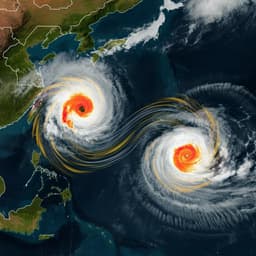
Earth Sciences
Escalating tropical cyclone precipitation extremes and landslide hazards in South China under global warming
X. Shi, Y. Liu, et al.
This research conducted by Xiaoming Shi, Yang Liu, Jianan Chen, Haoming Chen, Yueya Wang, Zhongming Lu, Ruo-Qian Wang, Jimmy C.-H. Fung, and Charles W. W. Ng delves into the alarming prospects of intensified tropical cyclone precipitation and landslide risks in South China due to global warming. It reveals that rainfall intensity could surpass conventional expectations, posing grave risks from compound disasters.
~3 min • Beginner • English
Introduction
The study addresses the uncertain response of tropical cyclone (TC) precipitation extremes to global warming, which bears directly on flood and landslide risks in tropical and subtropical coastal regions. While theory and prior assessments often cite a ~7% per K increase in moisture and precipitation sensitivity (Clausius–Clapeyron, CC), global climate models (GCMs) exhibit wide ranges (1.5%–11% K−1) and some high-resolution models suggest even higher values (13–17% K−1). Observations have also shown contrasting trends between inner-core and outer rainband precipitation. Because kilometer-scale resolution is required to explicitly resolve convective cloud dynamics in TCs, coarse-resolution GCMs struggle to capture key processes, impeding robust projections and risk assessments. To provide actionable, high-resolution projections for urban resilience planning, the authors develop a deep-learning-aided targeted downscaling strategy to identify and simulate extreme TC events over South China at 1-km resolution, and then assess the implications for landslide hazards in Hong Kong.
Literature Review
Prior work indicates a likely increase of TC precipitation of about 7% K−1 with warming, but GCMs show considerable spread (1.5%–11% K−1), and some higher-resolution global models suggest 13–17% K−1 sensitivity. Observation-based studies indicate potential decreases in inner-core TC rainfall alongside increases in outer rainbands, highlighting structural complexity. The scale dependence of convection implies that kilometer-scale modeling is necessary to capture convective processes in TCs; such global high-resolution simulations are computationally prohibitive for long periods. Previous targeted modeling has successfully assessed atmospheric river precipitation changes in California, motivating a selective high-resolution approach here. There are also gaps in comprehensive, high-resolution assessments of precipitation impacts on geohazards such as landslides, and uncertainties in process models (e.g., hydro-mechanical slope stability) further complicate risk estimation.
Methodology
The authors implement smart dynamical downscaling (SDD), a deep learning (DL)-aided selective approach to identify extreme precipitation-favorable large-scale patterns from a coarse-resolution climate simulation, followed by cloud-resolving regional simulations with WRF at 1-km resolution for the selected events.
- Deep learning predictor: A convolutional neural network (regular and channel-wise separable convolutions) trained for regression. Inputs: ERA5 reanalysis of geopotential, specific humidity, temperature, and u/v winds at 250, 500, 600, 700, 850, 925 hPa, at 6-hourly intervals over 1998–2015, coarsened to 1°×1°. Target: APHRODITE gridded daily precipitation (0.25°×0.25°), aggregated by taking the maximum daily rainfall within 4×4 blocks corresponding to each 1° grid cell. The model ingests a 48°×48° atmospheric window centered on each block and predicts the block’s subgrid daily maximum rainfall.
- Application to climate simulation: The trained DL model is applied to six-hourly CESM2 SSP5-8.5 output for 2015–2100 to generate a time series of daily subgrid maximum rainfall over South China and to identify extreme candidates. Present (2015–2034) and future (2081–2100) 20-year windows are defined.
- Event selection and WRF simulations: From the DL predictions, the top 16 events per period (top ~2.5% of ~600–700 rain events per 20 years) are selected. To test robustness, a parallel direct dynamical downscaling (DDD) selection using CESM2 1° precipitation identifies another top-16 list for each period. Overlaps between SDD and DDD are removed and the combined sets are re-ranked using WRF-simulated daily precipitation coarsened to 25 km, retaining the top 16 per period for analysis. In total, 25 (present) and 26 (future) WRF simulations were run across SDD and DDD. WRF uses four nested domains with 1-km grid spacing in the innermost domain and 75 vertical levels up to 10 hPa; physical parameterizations are detailed in Supplementary Table 1.
- Scale analysis of extremes: For each event, rolling spatiotemporal windows are applied to compute maximum precipitation accumulations across temporal scales (e.g., 1–48 h) and spatial averaging scales (e.g., 1–100 km), extracting the event-maxima for each scale pair. Sensitivity to warming is assessed by comparing present vs future top events and by regression against temperature increases.
- Convective dynamics diagnostics: Updraft cores (regions with w>1 m s−1) are identified hourly within 24 h around the maximum rainfall at heights throughout the troposphere, within 100 km of the maximum 24-h precipitation point (w analyzed from the 3-km domain). Statistics of updraft intensity, core size, proximity to cluster center, and movement speed are compared between present and future events. Spectral analyses of mid-level vertical velocity and composites (e.g., OLR) characterize organization scales; TC translation speeds are inferred from sea-level pressure low centers during the peak 24-h precipitation window.
- Landslide hazard assessment: Hong Kong’s 60,000+ man-made slopes are used with the Landslip Warning System (LWS), which relates landslide frequency to 24-h maximum rolling rainfall (MRR). Because future rainfall exceeds the historical range used to calibrate LWS, a modified LWS caps additional landslide increases beyond 800 mm (soil-cut) and 600 mm (rock-cut, fill, retaining walls), representing a conservative lower bound. For each event, the 24-h MRR field is shifted to the median center of the slopes to standardize exposure, while non-rainfall slope factors are held constant. Predicted numbers of landslides are computed using (i) present events, (ii) present events scaled by CC (7% K−1) and super-CC (13% K−1), and (iii) actual simulated future events, under both current and modified LWS formulations.
Key Findings
- GCM-scale sensitivity: CESM2 daily precipitation extremes over South China show 13% K−1 sensitivity (linear regression of decadal maxima vs decadal global mean temperature), implying ~52% increase for 4 K warming. The DL model’s predicted daily maxima increase from 202 mm (present) to 342 mm (future), indicating ~17% K−1; regression of decadal extremes yields 14% K−1 with 95% confidence.
- Scale-dependent extreme precipitation sensitivity: High-resolution WRF simulations show hourly, kilometer-scale extremes have sensitivities near CC (≈4–8% K−1). However, accumulated precipitation over larger space-time scales exhibits super-CC sensitivities, peaking around 18% K−1 for 12–18 h and 25–50 km scales. Under 4 K warming, 12 h–40 km accumulations increase by ~70%, while 1 h–1 km increases by ~15%. The maximum simulated hourly rainfall in present-period events reached 225 mm; simulated 24-h maxima are comparable to regional records.
- Structural changes in convection: Future events display slightly weaker median updrafts in the lower to mid-troposphere and reduced maxima aloft (by ~3 m s−1), but updraft cores expand horizontally (larger median and maximum diameters). Counts of updraft cores decrease at low levels, indicating suppression/merging of shallow cumulus and congestus into larger deep convective cores. Spectral energy in vertical motions increases at 10–100 km scales; e-folding radius of precipitation increases from ~15 km (present) to ~22 km (future). Convective cluster movement is faster at low levels; during peak-precipitation 24-h windows, TC center translation speed increases by ~24% in these South China cases.
- Event exemplars and accumulation increases: For the most intense event, 24-h MRR maxima at 1-km resolution increase from 753 mm (present) to 1163 mm (future), a ~54% rise corresponding to ~13% K−1.
- Landslide risks: Using present events scaled by CC (7% K−1, +28% over 4 K) under modified LWS yields an average of 191 landslides (+47% vs present mean 130). Using actual simulated future extreme events, the modified LWS predicts 250 landslides (+92%) and the current LWS predicts 410 landslides (+215%). Applying super-CC scaling (13% K−1) to present events with modified LWS reproduces the 250 average (+92%), matching the actual-future modified-LWS estimate.
Discussion
The results demonstrate that the sensitivity of TC-induced extreme precipitation to warming is strongly scale-dependent. While local, short-duration extremes scale near the Clausius–Clapeyron rate, accumulations over city-relevant spatial (20–50 km) and temporal (10–24 h) scales intensify at super-CC rates, exceeding double the CC rate in some regimes. This behavior is attributed to organizational changes in convection under warming—expanding deep convective cores and suppression/merging of shallow convection—rather than stronger updrafts. These structural changes enhance spatial and temporal overlap of heavy precipitation, boosting accumulations along TC rainbands and convective clusters. The implications for risk management are substantial: infrastructures designed around CC scaling may underestimate flood and landslide hazards. High-resolution modeling proves essential for capturing these dynamics, and scale-aware sensitivity estimates can aid in projecting hazard responses. The hazard analysis for Hong Kong indicates that nonlinear landslide responses can far outpace precipitation increases, signaling greater compounded risks in coastal cities under climate change.
Conclusion
By combining deep learning-guided case selection with 1-km cloud-resolving WRF simulations, the study provides robust, scale-aware estimates of how extreme TC precipitation in South China intensifies with warming. Key contributions include identifying super-CC sensitivity of accumulated precipitation at city scales (12–18 h and 25–50 km), linking this to the expansion and reorganization of convective cores, and quantifying the consequent amplification of landslide risks in Hong Kong (roughly +92% to +215% under 4 K warming, depending on warning system assumptions). The work underscores the necessity of kilometer-scale modeling for climate adaptation planning and suggests that empirically derived, scale-dependent sensitivities (e.g., ~13% K−1 for 24-h MRR) can inform hazard projections. Future research should expand event samples, improve physical parameterizations, deepen understanding of cloud-radiative feedbacks and TC structure changes, and integrate multi-hazard assessments for coastal urban resilience.
Limitations
- Model and parameterization constraints: Despite 1-km resolution, simulations still require turbulence and physics parameterizations, introducing uncertainties in convective processes and rainfall structure.
- Observational limitations: Sparse and uneven observational networks (stations and radar) limit validation of localized extreme rainfall and derived hazard models.
- Sample size and representativeness: Analysis focuses on a limited number of top extreme TC events in South China and on 24-h peak precipitation windows; results may not generalize to all TCs or other regions. Natural variability may obscure linear relationships with short-term temperature.
- Mechanistic scope: Potential drivers such as cloud-radiative feedbacks are hypothesized but not fully explored; upper-level dynamical changes and translation speed trends may vary regionally and with event selection.
- Hazard model assumptions: The modified LWS caps landslide frequency growth beyond historical rainfall ranges, providing a conservative lower bound; non-rainfall slope factors are held constant, and shifting rainfall to the median slope center simplifies spatial exposure patterns.
Related Publications
Explore these studies to deepen your understanding of the subject.







